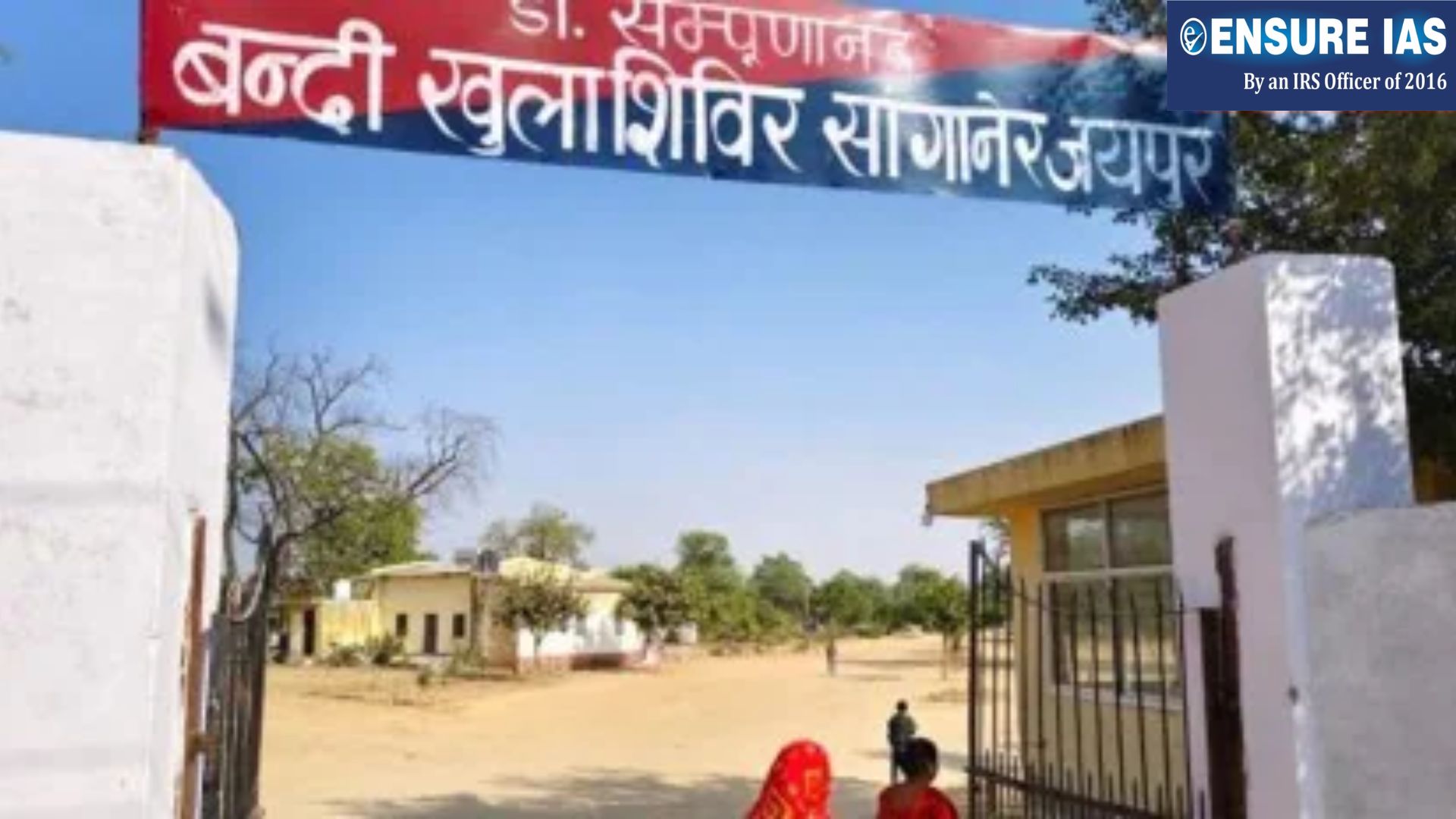- Courses
- GS Full Course 1 Year
- GS Full Course 2 Year
- GS Full Course 3 Year
- GS Full Course Till Selection
- Answer Alpha: Mains 2025 Mentorship
- MEP (Mains Enrichment Programme) Data, Facts
- Essay Target – 150+ Marks
- Online Program
- GS Recorded Course
- Polity
- Geography
- Economy
- Ancient, Medieval and Art & Culture AMAC
- Modern India, Post Independence & World History
- Environment
- Governance
- Science & Technology
- International Relations and Internal Security
- Disaster Management
- Ethics
- NCERT Current Affairs
- Indian Society and Social Issue
- NCERT- Science and Technology
- NCERT - Geography
- NCERT - Ancient History
- NCERT- World History
- NCERT Modern History
- CSAT
- 5 LAYERED ARJUNA Mentorship
- Public Administration Optional
- ABOUT US
- OUR TOPPERS
- TEST SERIES
- FREE STUDY MATERIAL
- VIDEOS
- CONTACT US
The Sanganer Open Jail
The Sanganer Open Jail
17-12-2024

- In December 2024, Supreme Court-appointed commissioner is scheduled to visit Sanganer open prison which is one of the largest open prisons in India.
Background: Dispute Over Land Allocation at Sanganer Open Jail
- In May 2024, the Supreme Court ruled that the size of open jail areas should not be reduced, stressing the need to protect these spaces.
- A social worker filed a contempt petition arguing that the Rajasthan government’s decision of allocation of jail land for constructing a hospital would harm the ecosystem of the jail, which is known for its effective and unique model.
- State Government’s Position: The government rejects claims of reducing the jail’s area. It stated that some structures for prisoners were built without authorization.
- The government proposes allocating additional land to shift prisoners into new shelters.
- Supreme Court’s Stance: In November, the Supreme Court highlighted the need to strike a balance between preserving the open correctional facility and meeting the hospital's requirements to serve the local community.
- The court appointed a commissioner to inspect the site and submit a report on the matter within four weeks.
What is an Open Prison?
- The Model Prisons and Correctional Services Act, 2023, defines an open correctional institution as a facility where eligible prisoners are confined under specific conditions, offering greater freedom outside a traditional prison.
- This system aims to support their rehabilitation post-release.
- Since prisons fall under the jurisdiction of state governments, states have established their own rules for setting up open prisons.
- Eligibility Criteria: Most states determine eligibility for open prisons based on:
- The nature of the prisoner’s crime.
- Their behaviour and conduct during incarceration (imprisonment).
- The portion of their sentence already served.
-
Features of Open Prisons:
- Security: Open prisons have minimal security compared to traditional jails.
- Activities: Inmates are allowed to engage in activities like agriculture and other productive work.
- Overcrowding Solution: They help reduce overcrowding in regular prisons.
- Rehabilitation: Open prisons make it easier for inmates to reintegrate into society after completing their sentences.
Types of Open Prisons
- Within Traditional Prisons: Some open prisons are designated sections within regular jails, offering inmates permission to leave for approved activities.
- Separate Colonies: In certain states, open prisons are independent settlements where inmates live with their families, though their movements are still monitored and restricted.
History of Open Jails in India
- The 1st open jail in independent India was set up in 1949 within a prison in Lucknow, Uttar Pradesh. Subsequently, similar open-air prisons were established across UP in 1952.
Justice Mulla Committee (1980-83)
- The All-India Committee on Jail Reform (1980-83), also known as the Justice Mulla Committee, mentioned that the idea of organizing open-air camps was introduced in 1952 at the Hague Conference.
- This initiative aimed to let prisoners experience a near-community life after serving a portion of their sentence.
- By 1983, there were 28-30 open jails, but only 13 states had formal rules for their operation.
Recommendations by Justice Mulla Committee: The committee proposed several measures to improve the functioning of open jails:
- Utilize land adjacent to closed prisons to establish open jails.
- Engage inmates in productive activities such as: agriculture, dairy farming, infrastructure projects like dam construction
- Ensure uniform wages for prisoners, addressing disparities where some states paid only token wages while others adhered to community-level wage standards.
Current Scenario
- According to the Prison Statistics of India 2022, there are 91 open jails in 17 states. These facilities have a total capacity of nearly 6,000 inmates, with ore than 4,400 prisoners currently housed.
- Rajasthan leads with 41 open jails, followed by Maharashtra with 19.
What Makes the Sanganer Open Jail Unique?
- The Sanganer Open Jail, also known as Sampurnanand Khula Bandi Shivir, was established in 1963 and named after a former Uttar Pradesh chief minister and Rajasthan governor.
- It has operated continuously unlike other open jails that faced closures due to issues like prison breaks.
Key Features
- Location and Population: Situated around 15 km from Jaipur, the jail houses 422 prisoners, including 14 women and their families.
- Family Integration: Inmates live with their spouses and children, fostering a family environment with minimal security.
- Self-Sufficiency: Prisoners pay for utilities like water and electricity and earn a living through local community jobs, such as running grocery shops. They also construct and maintain their homes with their earnings.
- Self-Governance: The jail operates a Bandi Panchayat, allowing inmates to self-regulate. They conduct roll calls twice daily to ensure all inmates return by the end of the day.
- Facilities: The complex includes a primary school accessible to local children, anganwadis, and a playground. Prisoners also have access to phones.
Inmate Selection Criteria
- Unlike other open jails where prisoners nearing the end of their sentence are admitted, Sanganer requires inmates to have completed at least 6 years and 8 months of their term. Their conduct is also evaluated before admission.
Legacy and Influence
- The Mulla Committee recommended that every state and union territory develop open camps like Sanganer, considering it the "final stage in the open camp movement."
- Although the Sanganer open jail has evolved over time, it remains globally distinctive.
- Inspired by Sanganer, 52 open-air camps have been established in Rajasthan, making it the state with the highest number of such facilities in India.
| Also Read | |
| UPSC Prelims Result | UPSC Daily Current Affairs |
| UPSC Monthly Mgazine | Previous Year Interview Questions |
| Free MCQs for UPSC Prelims | UPSC Test Series |
| ENSURE IAS NOTES | Our Booklist |




